| Pages:
1
..
3
4
5
6 |
hyfalcon
International Hazard
    
Posts: 1003
Registered: 29-3-2012
Member Is Offline
Mood: No Mood
|
|
I'm wondering if the original claimant and myself might be distant relatives since we carry the same spelling of last names.
|
|
|
IrC
International Hazard
    
Posts: 2710
Registered: 7-3-2005
Location: Eureka
Member Is Offline
Mood: Discovering
|
|
OK, makes sense as copper was rising in price even back then. In 75 the road was hell for 11 miles on down to the mine. Tore my muffler off getting in
there. Seemed like it had been in disrepair for years but I don't know how many. I bet they really improved it by 1989 when that pic was taken. Yeah,
hard to find anywhere with open mineral rights anymore. Even back then big companies were claiming entire quarter sections in blocks at a time. No
idea what is involved now though, since Clinton repealed the 1873 mining act laws back in the 90's. Probably companies lease the land from the
government today, but I have never looked into it since the late 80's.
"Science is the belief in the ignorance of the experts" Richard Feynman
|
|
|
IrC
International Hazard
    
Posts: 2710
Registered: 7-3-2005
Location: Eureka
Member Is Offline
Mood: Discovering
|
|
Trying to design a circuit for a tube I just bought. Problem is I cannot read the data sheet. Tried to OCR but my program does not appear to handle
Cyrillic. I had thought I could enter the OCR'ed text into a translate site if I could figure out how to turn it into text. Anyone here able to
translate?
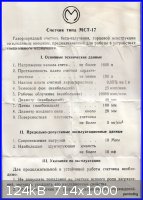
"Science is the belief in the ignorance of the experts" Richard Feynman
|
|
|
dontasker
Harmless

Posts: 40
Registered: 19-12-2012
Member Is Offline
Mood: Plopping
|
|
Tried a couple things and ended up with this:
| Quote: |
The counter type MST-17gas discharge counter ?????i????????, socket design with???????? windowed, designed to work ????????????-
???????????-??????????.1. The main technical bathrooms1. The voltage accounts . not 1600 in2. The length plateau ???????i .characteristics??????? not
less than 150 inW. ?????? plateau Cour des comptes specifications . 0.05 per cent, and 1 in4. ???????? von (highest) . . . . 25 ???i???.5. The
Workshop exposure (??????????1 .10006 -b. The diameter (??????????1 _ 41) ml7. length (the largest( 100 pits8. The diameter input window. . . . 20
mm9. Surface densitynot more than 5 meter south/xu'11. ????????-????????? ???????????????? dataI. load resistance 0 My2. ?????????? ???????????
containerhae more 1on the uf111. Instructions for ????????????for long x ????????? counter ??????-????: 1.Do not allow to enter the counter all kinds
of insect infestation,??????? impair his ???????????? properties.2. Protect from counter and ???????????? damage.pent?dDO� |
Not really sure what "The main technical bathrooms" is supposed to mean.
|
|
|
bfesser
Resident Wikipedian
    
Posts: 2114
Registered: 29-1-2008
Member Is Offline
Mood: No Mood
|
|
IrC, my OCR & translation were similarly garbled, but here's my own interpretation…
<table bgcolor="#EEEEEE"><tr><td colspan="2"
align="center"><strong>MCT-17</strong></td></tr><tr><td colspan="2" align="center"><u>Main technical
data:</u></td></tr><tr><td>Min. working potential:</td><td>1600
V</td></tr><tr><td>Plateau length:</td><td>≥ 150 V</td></tr><tr><td>Plateau
slope:</td><td>≤ 0.05 %</td></tr><tr><td>Inherent background:</td><td>≤ 25
CPM</td></tr><tr><td>Maximum rate:</td><td>10000 CPM</td></tr><tr><td>Diameter
(max.):</td><td>40 mm</td></tr><tr><td>Length (max.):</td><td>100
mm</td></tr><tr><td>Mica window dia.:</td><td>20 mm</td></tr><tr><td>Mica window
density:</td><td>5 mg/cm<sup>2</sup></td></tr><tr><td align="center" colspan="2"><u>Max.
permissible operating data:</u></td></tr><tr><td>Anode load resist.:</td><td>10
MΩ</td></tr><tr><td>Inter-electrode cap.:</td><td>< 10 pF</td></tr></table>
If you care to see it, I came up with this Russian Cyrillic OCR: | Quote: | | Счетчик типа МСТ-1 7
Газоразрядный счетчик
бета-излучения. торцевой
конструкции со слюдяным
окошком.
предназначенный для
работы в устройствах
специа ния. ’ ' 1. Основные
технические Данные !.
Напряжение начала счета
. . не более 1600 в 2.
Протяженность плато
счетной характе- ристики
. . . . . . . . не менее 150 в 3. Наклон
плато счетной
характеристики . 0.092; на 1 в 4.
Темновой фон (наибольшим
. . . .5пчч нив . Рабочее
облучение (наибольшее:
Диаметр (наибольшпйд .
Длина (наибольшая) 1 г: о. 8.
Диаметр входного ониа . . . .
около 20 мм 9. Поверхностная
плотность счетчика не
более 5 мг/см’ ||.
Предельно-допустимые
эксплуатационные
данные 1, Сопротивление
нагрузки . . . . . . 10 Мом до
Наибольшая шунтирующая
емкость не более 10 пф Ш.
Указания по
эксплуатации Для
продолжительной и
устойчивой работы
счетчика необхо- дИМ01 1. Не
допускать попадания на
счетчик всякого рода
загрязне- ннй, могущих
ухудшить его
изоляционные свойства. 2.
оберегать счетчик от
ударов и механических
повреждений. |
Which Google translates
to: | Quote: | | Counter type MCT- July 1 gas-discharge counter beta radiation. end design with a mica window . designed for use in devices of specialists . ' ' 1 .
Main technical data ! . Starting voltage account. . not more than 1600 2 . The length of the plateau of the counting characteristics . . . . . . . .
not less than 150 3 . The slope of the plateau of the counting characteristics . 0.092 ; on 1 in 4 . Dark background ( most .... 5pchch cornfields .
Operating exposure ( highest Diameter ( naibolshpyd . Length (maximum ) 1 g : Fr. 8. Input onia diameter of about 20 mm .... 9. Counter surface
density of not more than 5 mg / cm '| |. Maximum permissible operating data 1 load resistance ...... 10 megohms to Most shunt capacitance of less than
10 pF Sh operating instructions for continuous and stable operation of the necessary counter - dIM01 1. avoid contact to counter any kind of pollution
IDD that may impair its insulating properties. 2 . counter protect against shock and mechanical damage. |
dontasker, I think the algorithm misread 'the main technical specifications.'
[edit] I wonder if Ukrainian would be a better fit, as I think many tubes were manufactured there.
[Edited on 12.2.14 by bfesser]
|
|
|
IrC
International Hazard
    
Posts: 2710
Registered: 7-3-2005
Location: Eureka
Member Is Offline
Mood: Discovering
|
|
Thanks to both of you for putting in effort on this, it gives me enough information I think. I had guessed the voltage was 1,600 and load 10 megohm
because it seemed to be logical but feel much better having verification. This tube is great and hard to find. Did not want to damage it. What OCR did
you use? All I have is the built in scan to OCR in my Lexmark printer/scanner and it can only handle A-Z, 0-9. Last question, it has an end cover
(Cu?) disk with tiny hole. I assumed it was a de-scaler by limiting input aperture (window size). Does anything in the text indicate the amount of
reduction and to what type radiation? Looking at "Наклон плато
счетной характеристики .
0.092", I was wondering if 0.092 represented the factor reduced from 100 percent with cover in place.
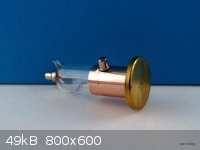 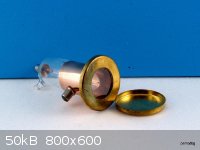
I should add: what about KOI8-R? The seller is in Bulgaria, so it would make sense he was selling surplus from the Ukraine.
http://en.wikipedia.org/wiki/KOI8-R
Also is there useful information on these two pages? I would do this myself using google translate but all I have are images not text to work with.
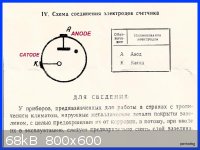 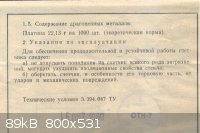
Unrelated to this post, rather than make another post I'll put some interesting links I found here:
http://www.theremino.com/en/blog/gamma-spectrometry/
http://www.theremino.com/en/technical/schematics/
http://www.theremino.com/en/blog/geigers-and-ionchambers/
https://sites.google.com/site/diygeigercounter/
http://forum.pololu.com/viewtopic.php?f=6&t=1453
http://www.instructables.com/id/Arduino-Geiger-Counter/?ALLS...
http://radgoes.blogspot.com/2011/04/hv-inverter-circuit-for-...
http://www.cooking-hacks.com/documentation/tutorials/geiger-...
[Edited on 2-12-2014 by IrC]
"Science is the belief in the ignorance of the experts" Richard Feynman
|
|
|
bfesser
Resident Wikipedian
    
Posts: 2114
Registered: 29-1-2008
Member Is Offline
Mood: No Mood
|
|
I run Linux, so this may not be as helpful as you'd hoped:
To generate the OCR, I first cropped, converted to grey-scale, and adjusted the brightness/contrast of the image in <a href="http://www.gimp.org/"
target="_blank">GIMP</a> <img src="../scipics/_ext.png" />, then exported to PNG. I <del>converted the PNG to PDF using <a
href="http://www.imagemagick.org/script/index.php" target="_blank">ImageMagick</a> <img src="../scipics/_ext.png" /> and</del>
imported the <del>PDF</del> [PNG] into <a href="http://symmetrica.net/cuneiform-linux/yagf-en.html" target="_blank">YAGF</a>
<img src="../scipics/_ext.png" />, a GUI for <a href="https://code.google.com/p/tesseract-ocr/" target="_blank">tesseract-ocr</a>.
I generated the OCR after adjusting the text-box area and installing/selecting the Russian OCR library (tesseract-ocr-rus with aspell-ru). From
there, I just copy-pasted the Russian Cyrillic OCR into <a href="http://translate.google.com/" target="_blank">Google Translate</a>
<img src="../scipics/_ext.png" /> and selected Russian to English.
Unfortunately, there are no details in the text for dose-rate coefficients or the shield. The "0.092" was a mis-recognition of "0.05" from "The slope
of the plateau of the counting characteristics . 0,05 % per 1 V." I verified the numbers in my table with those from the original image and what
little Russian I've learned to read, ignoring the OCR entirely.
[edit] Manually entered one character at a time: | Quote: | 1.5. Содержание
драгоценных металлов:
Платина 22,13 г на 1000 шт.
(теоретическая норма).
2. Указания по
эксплуатации
Для обеспечения
продолжительной и
устойчивой работы
счетчика следует:
а) не допускать
попадания на счетчик
всякого рода
загрязнений могущих
ухудшить изоляционные
свойства стекла;
б) оберегать счетчик, в
особенности его
торцовую часть, от
ударов и механических
повреждений.
Технические условия 3. 394. 047
ТУ.
16 Окт 1980 ОТН-7 |
<table align="center" class="quote"
cellspacing="0" cellpadding="0"><tr><td class="quote">Translation:</td></tr><tr><td class="quotemessage">1.5.
Contents of precious metal:
Platinum 22.13 g per 1000 pieces. (theoretical norm).
2. Notes on operation
To ensure continued and stable operation of the meter one should:
a) avoid contact of the counter to any kind of pollution which may degrade the insulating properties of the glass;
b) protect the counter, in particular its front end portion, from shock and mechanical damage.
Technical conditions 3. 394. 047 TU.
October 16, 1980 OTH-7</td></tr></table>Did you receive hard copies of the data sheet with the tube?
[note] Thank you to Theoretic for suggesting several revisions to my somewhat awkward translations.
[Edited on 13.2.14 by bfesser]
|
|
|
IrC
International Hazard
    
Posts: 2710
Registered: 7-3-2005
Location: Eureka
Member Is Offline
Mood: Discovering
|
|
Just one sheet, the image I posted above, MST-17 and the back side MST-17 MICA WINDOW8. Resolution poor as I had to reduce the size for posting. I can
mail it to you if you PM your mailing address (you already have mine from a PM a while back). I don't need it as I have the full res scans I made and
tend to keep all important data in my computer anyway (and on stored DVD's as backup). Actually easier to read it on screen than on the paper itself
anyway. The other images are from the auction page:
http://www.ebay.com/itm/151092929730?ssPageName=STRK:MEWNX:I...
You can see the other images on the page I bought it from. He has I think 3 left and the price was great. Took 2 or 3 weeks to arrive but came in
perfect condition, well packed in mail you have to sign for which to me is even better security of arrival than regular mail.
Thanks for your work on this. He has three other similar tubes but I opted for buying two of the $30 beta tubes rather than the higher priced Alpha
tubes:
http://www.ebay.com/itm/GEIGER-MULLER-COUNTERS-SBT-7-MICA-WI...
http://www.ebay.com/itm/GEIGER-MULLER-COUNTER-SAT-7-REGISTER...
http://www.ebay.com/itm/GEIGER-MULLER-COUNTER-SI9A-REGISTER-...
If I was rich I would grab them all as from long searching I know they are difficult to find, especially at reasonable cost.
[Edited on 2-12-2014 by IrC]
"Science is the belief in the ignorance of the experts" Richard Feynman
|
|
|
bfesser
Resident Wikipedian
    
Posts: 2114
Registered: 29-1-2008
Member Is Offline
Mood: No Mood
|
|
No problem. I'd love to see the original, and I would enjoy the chance to fully translate it. I have the opposite tendency, having difficulty
reading anything on a computer screen, and finding hard copy much easier. I'll be mailing an envelope of unidentified electronic components to you,
soon.
I had been browsing eBay for similar mica-window tubes over the last few weeks. Unfortunately, I don't have the funds to purchase any just yet. In
the meantime I've been occupied with trying to source JFETs for home-brew ion chamber detectors, and scrounging miscellaneous parts from my local
surplus shop (<a href="http://ax-man.com/whereweare/ax1map.html" target="_blank">Ax-Man</a> <img src="../scipics/_ext.png" /> . .
[edit] I thought the description sounded familiar. I had that listing in my watch list.
On a related note, I've been thinking about purchasing some vacuum tube anode caps for reliable, safe, and non-permanent connections with tubes. I
measured the ends of an SI-3BG and an SBM-20 with callipers, and think these <a href="http://www.ebay.com/itm/321011263672"
target="_blank">¼" anode caps</a> <img src="../scipics/_ext.png" /> will work for them. I'm sure there are caps to fit your
new tube, as well.
[Edited on 12.2.14 by bfesser]
|
|
|
IrC
International Hazard
    
Posts: 2710
Registered: 7-3-2005
Location: Eureka
Member Is Offline
Mood: Discovering
|
|
http://www.ebay.com/itm/130888052558?ssPageName=STRK:MEWNX:I...
Trust me you can try every jfet on the planet but if they are not specifically electrometer jfets, performance sucks. It is all about Idss. From 2 ma
to 20 ma typical for most numbers, only around 0.05 ma for the 2N4117A. You can spend endless time blowing money on circuits which without being based
on a very low Idss jfet, will never be what you hoped for. By the way if building a photodiode detector is your goal, this parameter is even more
important. No jfet I have ever found comes close by orders of magnitude to the 2n4117A.
Attachment: 2N4117.PDF (28kB)
This file has been downloaded 583 times
"Science is the belief in the ignorance of the experts" Richard Feynman
|
|
|
bfesser
Resident Wikipedian
    
Posts: 2114
Registered: 29-1-2008
Member Is Offline
Mood: No Mood
|
|
Completed Translation
<strong>IrC</strong>, thanks for the advice. I already had that eBay listing in my watch list, along with a couple others. The 2N7117A
is also available new from Mouser, but the PN4117A has been discontinued, though I have seen it on eBay. I also plan to pick up some 2N5484 JFETs for
less demanding applications. Quote: Originally posted by IrC  | | Trying to design a circuit for a tube I just bought. Problem is I cannot read the data sheet. Anyone here able to translate? |
I compiled everything from the two scans:<table align="center" class="quote" cellspacing="0" cellpadding="0"><tr><td
class="quote">Russian (Cyrillic) Transcription:</td></tr><tr><td class="quotemessage" style="font-family:
monospace;"><table><tr><td colspan="3" align="center"><img src="http://www.scimad.org/users/bfesser/m_circle.png" alt="Ⓜ
MELZ logo" width="50" /></td></tr><tr style="height: 5px;"></tr><tr><td style="text-align: center; font-size:
12pt; font-weight: bold;" colspan="3">Счетчик типа
МСТ-17</td></tr><tr style="height: 5px;"></tr><tr><td style="text-align: justify; text-indent:
15pt;" colspan="3">Газоразрядный
счетчик бета-излучения,
торцевой конструкции со
слюдяным окошком
предназначенный для
работы в устройствах
специального
назначения.</td></tr><tr style="height:
5px;"></tr><tr><td style="text-align: center; font-weight: bold;" colspan="3">I.
Основные технические
данные</td></tr><tr style="height: 5px;"></tr><tr><td style="text-indent:
15pt;">1.</td><td style="text-align: justify;">Напряжение
начала счета … не
более</td><td style="white-space: nowrap;">1600 в</td></tr><tr><td
style="text-indent: 15pt;" valign="top">2.</td><td style="text-align:
justify;">Протяженность плато
счетной характеристики
… не менее</td><td style="white-space: nowrap;" valign="bottom">150
в</td></tr><tr><td style="text-indent: 15pt;">3.</td><td style="text-align:
justify;">Наклон плато счетной
характеристики</td><td style="white-space:
nowrap;">0,05 % на 1 в</td></tr><tr><td style="text-indent: 15pt;">4.</td><td style="text-align:
justify;">Темновой фон
(наибольший)</td><td style="white-space: nowrap;">25
имп/мин.</td></tr><tr><td style="text-indent: 15pt;">5.</td><td
style="text-align: justify;">Рабочее облучение
(наибольшее)</td><td style="white-space: nowrap;">10000
имп/мин.</td></tr><tr><td style="text-indent: 15pt;">6.</td><td
style="text-align: justify;">Диаметр
(наибольший)</td><td style="white-space: nowrap;">40
мм</td></tr><tr><td style="text-indent: 15pt;">7.</td><td style="text-align:
justify;">Длина (наибольшая)</td><td
style="white-space: nowrap;">100 мм</td></tr><tr><td style="text-indent: 15pt;">8.</td><td
style="text-align: justify;">Диаметр входного
окна … около</td><td style="white-space: nowrap;">20
мм</td></tr><tr><td style="text-indent: 15pt;" valign="top">9.</td><td style="text-align:
justify;">Поверхностная
плотность счетчика … не
более</td><td style="white-space: nowrap;">5
мг/см²</td></tr><tr style="height: 5px;"></tr><tr><td style="text-align: center;
font-weight: bold;" colspan="3">II.
Предельно-допустимые
эксплуатационные
данные</td></tr><tr style="height: 5px;"></tr><tr><td style="text-indent:
15pt;">1.</td><td style="text-align:
justify;">Сопротивление
нагрузки</td><td style="white-space: nowrap;">10
Мом</td></tr><tr><td style="text-indent: 15pt;" valign="top">2.</td><td style="text-align:
justify;">Наибольшая
шунтирующая емкость …
не более</td><td style="white-space: nowrap;" valign="bottom">10
пф</td></tr><tr><td colspan="3"></td></tr><tr style="height: 5px;"></tr><tr><td
style="text-align: center; font-weight: bold;" colspan="3">III. Указания по
эксплуатации</td></tr><tr style="height:
5px;"></tr><tr><td style="text-align: justify; text-indent: 15pt;" colspan="3">Для
продолжительной и
устойчивой работы
счетчика
необходимо:</td></tr><tr><td style="text-indent: 15pt; text-align:
justify;" colspan="3">1. Не допускать
попадания на счетчик
всякого рода
загрязнений, могущих
ухудшить его
изоляционные
свойства.</td></tr><tr><td style="text-indent: 15pt; text-align: justify;"
colspan="3">2. Оберегать счетчик от
ударов и механических
повреждений.</td></tr><tr><td
colspan="3"></td></tr><tr style="height: 5px;"></tr><tr><td style="text-align: center; font-weight: bold;"
colspan="3">IV. Схема соединения
электродов
счетчика</td></tr><tr style="height: 5px;"></tr><tr><td
colspan="3"></td></tr><tr><td align="center" colspan="3"><table align="center"><tr><td
align="center"><img src="http://www.scimad.org/users/bfesser/MCT-17_diag.png" width="80" /></td><td valign="top" style="padding:
10px;"><table cellspacing="0" style="border: 1px solid black; border-collapse:collapse;"><tr><td style="border: 1px solid black;
padding: 5px;">Обозначение</td><td style="border: 1px solid black;
padding: 5px;">Наименование
электродов</td></tr><tr><td style="text-align: center; padding:
5px;">А<br />К</td><td style="padding: 5px;">Анод<br
/>Катод</td></tr></table></td></tr></table></td></tr><tr
style="height: 5px;"></tr><tr><td style="text-align: center;" colspan="3">ДЛЯ
СВЕДЕНИЯ:</td></tr><tr style="height: 5px;"></tr><tr><td
style="text-align: justify; text-indent: 15pt;" colspan="3">У приборов,
предназначенных для
работы в странах с
тропическим климатом,
наружные металлические
детали покрыты
вазелином, с целью
предохранения их от
коррозии, а потому, при
вводе их в эксплуатацию,
следует предварительно
снять слой
вазелина.</td></tr></table></td></tr></table><table
align="center" class="quote" cellspacing="0" cellpadding="0"><tr><td class="quote">English
Translation:</td></tr><tr><td class="quotemessage" style="font-family: monospace;"><table><tr><td colspan="3"
align="center"><img src="http://www.scimad.org/users/bfesser/m_circle.png" alt="Ⓜ MELZ logo" width="50" /></td></tr><tr
style="height: 5px;"></tr><tr><td style="text-align: center; font-size: 12pt; font-weight: bold;" colspan="3">Counter type
MST-17</td></tr><tr style="height: 5px;"></tr><tr><td style="text-align: justify; text-indent: 15pt;"
colspan="3">Gas-discharge counter of beta radiation, with mica end window design intended for operation in special purpose
devices.</td></tr><tr style="height: 5px;"></tr><tr><td style="text-align: center; font-weight: bold;"
colspan="3">I. Basic technical data</td></tr><tr style="height: 5px;"></tr><tr><td style="text-indent:
15pt;">1.</td><td style="text-align: justify;">Starting counting voltage … not more than</td><td
style="white-space: nowrap;">1600 V</td></tr><tr><td style="text-indent: 15pt;" valign="top">2.</td><td
style="text-align: justify;">Extent of counting plateau characteristics … not less than</td><td style="white-space: nowrap;"
valign="bottom">150 V</td></tr><tr><td style="text-indent: 15pt;">3.</td><td style="text-align: justify;">Slope
of counting plateau characteristics</td><td style="white-space: nowrap;">0.05 % per 1 V</td></tr><tr><td
style="text-indent: 15pt;">4.</td><td style="text-align: justify;">Dark background (maximum)</td><td style="white-space:
nowrap;">25 pulses/min.</td></tr><tr><td style="text-indent: 15pt;">5.</td><td style="text-align:
justify;">Operating radiation (at most)</td><td style="white-space: nowrap;">10000 pulses/min.</td></tr><tr><td
style="text-indent: 15pt;">6.</td><td style="text-align: justify;">Diameter (maximum)</td><td style="white-space:
nowrap;">40 mm</td></tr><tr><td style="text-indent: 15pt;">7.</td><td style="text-align: justify;">Length
(maximum)</td><td style="white-space: nowrap;">100 mm</td></tr><tr><td style="text-indent:
15pt;">8.</td><td style="text-align: justify;">Diameter of the entrance window … about</td><td style="white-space:
nowrap;">20 mm</td></tr><tr><td style="text-indent: 15pt;" valign="top">9.</td><td style="text-align:
justify;">Surface density of the counter … not more than</td><td style="white-space: nowrap;">5
mg/cm²</td></tr><tr style="height: 5px;"></tr><tr><td style="text-align: center; font-weight: bold;"
colspan="3">II. Maximum permissible operation data</td></tr><tr style="height: 5px;"></tr><tr><td
style="text-indent: 15pt;">1.</td><td style="text-align: justify;">Load impedance</td><td style="white-space: nowrap;">10
MΩ</td></tr><tr><td style="text-indent: 15pt;" valign="top">2.</td><td style="text-align:
justify;">Maximum bypass capacitance … not more than</td><td style="white-space: nowrap;" valign="bottom">10
pF</td></tr><tr><td colspan="3"></td></tr><tr style="height: 5px;"></tr><tr><td
style="text-align: center; font-weight: bold;" colspan="3">III. Notes on operation</td></tr><tr style="height:
5px;"></tr><tr><td style="text-align: justify; text-indent: 15pt;" colspan="3">For continuous and stable operation of the counter
it is necessary to:</td></tr><tr><td style="text-indent: 15pt; text-align: justify;" colspan="3">1. Keep the counter from
contact with any kind of contamination which might impair its insulating properties.</td></tr><tr><td style="text-indent: 15pt;
text-align: justify;" colspan="3">2. Protect from counter from blows and mechanical damage.</td></tr><tr><td
colspan="3"></td></tr><tr style="height: 5px;"></tr><tr><td style="text-align: center; font-weight: bold;"
colspan="3">IV. Counter electrode connection diagram</td></tr><tr style="height: 5px;"></tr><tr><td
colspan="3"></td></tr><tr><td align="center" colspan="3"><table align="center"><tr><td
align="center"><img src="http://www.scimad.org/users/bfesser/MST-17_diag.png" width="80" /></td><td valign="top" style="padding:
10px;"><table cellspacing="0" style="border: 1px solid black; border-collapse:collapse;"><tr><td style="border: 1px solid black;
padding: 5px;">Notation</td><td style="border: 1px solid black; padding: 5px;">Electrode
designation</td></tr><tr><td style="text-align: center; padding: 5px;">A<br />C</td><td style="padding:
5px;">Anode<br />Cathode</td></tr></table></td></tr></table></td></tr><tr style="height:
5px;"></tr><tr><td style="text-align: center;" colspan="3">NOTICE:</td></tr><tr style="height:
5px;"></tr><tr><td style="text-align: justify; text-indent: 15pt;" colspan="3">With instrument versions designated for use in
countries with tropical climates, exterior metal parts are covered with Vaseline, for protection against corrosion, but because of this, in their
commissioning, you must first remove the layer of petroleum jelly.</td></tr></table></td></tr></table>By the way,
I looked up the manufacturer's logo out of curiosity, it was <a href="http://rutubes.com/category/melz-tube-moscow-russia/"
target="_blank">Moscow Electric Plant, "MELZ"</a> <img src="../scipics/_ext.png" />. Curiously, they're still around, but they're now
known as Moscow <a href="http://www.melz-evp.ru/" target="_blanK">Electro-Lamp Plant, MELZ-EVP</a> <img src="../scipics/_ext.png"
/>. I don't think they've made radiation detection tubes in a few decades, though.
Attachment: 2n5484.pdf (355kB)
This file has been downloaded 477 times
|
|
|
IrC
International Hazard
    
Posts: 2710
Registered: 7-3-2005
Location: Eureka
Member Is Offline
Mood: Discovering
|
|
Thanks for the tedious hard work. That 2N5484 jfet will be as bad if not worse than a cheaper MPF102 for electrometer or gamma photodiode detection
front ends although it may have a better top end frequency wise. Good for a second stage amplifier, would even work OK for a static field monitor*.
You must get the 2N4117. In a metal case preferably. You must get down to the 0.05 ma Idss range or better for serious top quality work.
* http://amasci.com/emotor/chargdet.html
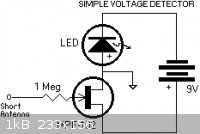
Instead of an LED you can make a meter circuit say with a 50 ua movement, with short antenna on gate floating away from the device (touching nothing).
It will slam the needle back and forth waving a comb (first run through your hair) from ten or more feet away. Even the MPF102 works great for this. I
built one meter with both N and P jfets, two meters, which can measure field strength and polarity from far away. Storms approaching from miles away.
However for work with ion chambers or low dark current devices Idss becomes very important.
"Science is the belief in the ignorance of the experts" Richard Feynman
|
|
|
Marvin
National Hazard
   
Posts: 995
Registered: 13-10-2002
Member Is Offline
Mood: No Mood
|
|
I could have done with reading that 2N4117 datasheet 2 years ago. I spent weeks off and on trying to figure out the difference between 2N4117A and
PN4117A. The only datasheets I could find had much less data and described the PN part as a "switch" but it was 1/20th of the price. I bought a few
for input clamping following end of life warnings. Had I known it was the same thing I'd have bought a bucketful.
|
|
|
IrC
International Hazard
    
Posts: 2710
Registered: 7-3-2005
Location: Eureka
Member Is Offline
Mood: Discovering
|
|
Wish I had a large quantity, still waiting for 30 in mail which cost $45 with shipping, $1.25 each. Found this interesting circuit. They mention
removing the glass window on diode and replacing with black Mylar to allow Alpha/Beta also. Had to squish pic so the resolution not as good but here
is the link if you want the text and a better quality image:
http://www.next.gr/sens-detectors/rf-radiation/wideband-radi...
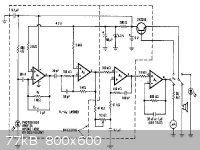
Main site has a lot of useful circuits (both RF and Radiation):
http://www.next.gr/sens-detectors/rf-radiation/
[Edited on 2-15-2014 by IrC]
"Science is the belief in the ignorance of the experts" Richard Feynman
|
|
|
Marvin
National Hazard
   
Posts: 995
Registered: 13-10-2002
Member Is Offline
Mood: No Mood
|
|
There are some good deals on the 2N part, but killed for me by the shipping cost.
Interesting schematic. Seems to be a mistake in it. Pin 14 goes to the 4.3v line and I think it should cross this and connect with the 9v line above
it.
|
|
|
IrC
International Hazard
    
Posts: 2710
Registered: 7-3-2005
Location: Eureka
Member Is Offline
Mood: Discovering
|
|
Quote: Originally posted by Marvin  | There are some good deals on the 2N part, but killed for me by the shipping cost.
Interesting schematic. Seems to be a mistake in it. Pin 14 goes to the 4.3v line and I think it should cross this and connect with the 9v line above
it. |
Good thing you saw that, I just found the circuit online and did not carefully study it before I posted the image. Sucks when they draw schematics
then fail to proof read them before dumping them online. I don't have a decent art program but I fixed it in a sort of sloppy way. I would have caught
that if I tried to actually build it but I'm glad you saw it before others wasted time not understanding why their circuit failed to operate. I wonder
how many globally have built that then ended up pulling hair out trying to get it functioning. At least thanks to your sharp eye and my sloppy artwork
now they can get it here in a functioning version? Yeah your right, some sellers are insane on shipping. I found one seller that wanted ten bucks for
ten, plus 9.99 to mail it. We all know under a buck is total cost to put ten tiny parts in an envelope with a stamp on it. Which often is how I do get
things that small shipped after paying an inflated shipping cost.
Edit to add PDF for LM3900:
Attachment: lm3900-n.pdf (486kB)
This file has been downloaded 965 times
[Edited on 2-15-2014 by IrC]
"Science is the belief in the ignorance of the experts" Richard Feynman
|
|
|
Marvin
National Hazard
   
Posts: 995
Registered: 13-10-2002
Member Is Offline
Mood: No Mood
|
|
What surprised me more was 9.0/10 from 88 votes, 800+ views and no comments. Reminded me of this.
|
|
|
IrC
International Hazard
    
Posts: 2710
Registered: 7-3-2005
Location: Eureka
Member Is Offline
Mood: Discovering
|
|
Found a great circuit on that link you just gave.
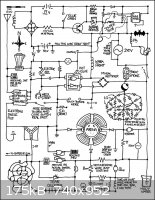
"Science is the belief in the ignorance of the experts" Richard Feynman
|
|
|
Marvin
National Hazard
   
Posts: 995
Registered: 13-10-2002
Member Is Offline
Mood: No Mood
|
|
The detector circuit is quite similar to Maxim app note 2236, bfesser posted on page 3 of this thread. I knew it reminded me of something.
|
|
|
bfesser
Resident Wikipedian
    
Posts: 2114
Registered: 29-1-2008
Member Is Offline
Mood: No Mood
|
|
Fixed, full-resolution:
<a href="http://www.scimad.org/users/bfesser/135-9425.png" target="_blank"><img src="http://www.scimad.org/users/bfesser/135-9425.png"
width="250" border="1" /></a> <img src="../scipics/_ext.png" valign="top" />
Attachment: 135-9425.pdf (36kB)
This file has been downloaded 613 times
[Edited on 21.2.14 by bfesser]
|
|
|
IrC
International Hazard
    
Posts: 2710
Registered: 7-3-2005
Location: Eureka
Member Is Offline
Mood: Discovering
|
|
My latest Russian Neutron Counter tube SNM-9 just arrived today and in my search for information to build a working circuit I found a useful table. At
least useful for others, my number is not in it. Sucks but there it is, somewhat useful as it does give information on the tube type in general which
I find helpful. When in doubt and lacking information it is often safe to design a circuit based upon similar components. Or at least the smoke
appears less often? Below is the table. I translated and rebuilt it in English in the document file. So if anyone is building neutron counters using a
tube in the list the doc file attached may be of use. Nothing was listed as to load resistance but every circuit I have found calls for a 10 meg
resistor. Marvin called these 'Corona tubes' but honestly I have found little information on proper circuit design to run them. The most I have is
2,000 to 2,800 volts, happy around 2,400 volts with a ten meg-ohm load resistor.
СЧЕТЧИКИ НЕЙТРОНОВ
№
п.п. Тип прибора
Технические условия
Ном. рабочий диапазон
напряжений,
В Напряжение начала
счета (заж. корон. разряда , ,
В Собственный фон,
с-1
не более Фоновый ток
коронного разряда,
мкА
не более Габаритные
размеры,
мм Масса,
г
1. СНМ 11 ОДО.339.070ТУ 1500-3000 600-700 0.017 27.5 Ø18.5*336 50.0
2. СНМ 12 ОДО.339.070ТУ 500-700 не менее 400 0.008
11.0 Ø8.5*215 16.2
3. СНМ 13 ОДО.339.070ТУ 450-600 не менее 450 8.10-5
5.5 Ø8.5*85 11.5
4. СНМ 14 ОДО.339.070ТУ 450-600 600-700 0.017 27.5 Ø18.5*153 24.0
5. СНМ 16 ОДО.339.071ТУ 2000-2800 не менее 2000 0.083
25.0 Ø18.5*158 30.0
6. СНМ 17 ОДО.339.071ТУ 2000-2800 не менее 2000 0.83
25.0 Ø18.5*251 40.0
7. СНМ 18-1 ОДО.339.546ТУ 1700-3000 1450-1650 0.83 25.0 Ø32.0*320 180.0
8. СНМ 32 ОДО.339.281ТУ 1500-3000 600-700 0.017 25.0 Ø18.5*323 42.0
9. СНМ 42 ОДО.339.281ТУ 1500-3000 600-700 0.017 25.0 Ø18.5*153 25.0
10. СИ 19Н ОДО.339.142ТУ 2000-2800 600-1750 0.1 15.0 Ø33.3*218 130.0
11. СНМ 18 ОДО.339.072ТУ 1275-1500 --- 0.05 --- Ø32.0*320 180.0
This was a table but the formatting does not come out right in this post. I have heard from some my old win 2k doc format (Word 6) will not open on
newer machines so included is a text version. Also I just edited both files to include another table I found which lists a СНМ 9.
Since C in Russian is the English S I am thinking it is the right number/specs for my newest tube. However now I wonder why the only circuit I found
online shows it running at 2,200 volts. Very confusing. Here is one data sheet as well, in Russian. I can use google translate on text but not images.

Attachment: Neutron counter.doc (13kB)
This file has been downloaded 658 times
Attachment: Neutron counter.txt (3kB)
This file has been downloaded 731 times
[Edited on 2-21-2014 by IrC]
"Science is the belief in the ignorance of the experts" Richard Feynman
|
|
|
bfesser
Resident Wikipedian
    
Posts: 2114
Registered: 29-1-2008
Member Is Offline
Mood: No Mood
|
|
Ooh, another translation project. I'll get to work right away. I must be a masochist, because I thoroughly enjoyed doing the last one. On a closely
related note, I'm working on making a PDF of the previous translation, and will be uploading that soon as well. Thanks for sharing these, and please
keep us updated on your new detectors.
|
|
|
IrC
International Hazard
    
Posts: 2710
Registered: 7-3-2005
Location: Eureka
Member Is Offline
Mood: Discovering
|
|
Quote: Originally posted by bfesser  | | Ooh, another translation project. I'll get to work right away. I must be a masochist, because I thoroughly enjoyed doing the last one. On a closely
related note, I'm working on making a PDF of the previous translation, and will be uploading that soon as well. Thanks for sharing these, and please
keep us updated on your new detectors. |
Actually, I decided to unpack it and found this sheet rolled up in the box, came with the tube. Far more valuable to me if you feel like translating
something. I am wondering if the load is 10 meg-ohms, and operating voltage is 1,300 volts. Also load capacitance, other parameters, etc.. Had to
squish the scan to post.
Confusing is the 700 listed on the sheet, in other tables as corona voltage. Yet 1,300 in that table was the operating voltage. When Marvin mentioned
corona tubes that got me searching and thinking, yet not much is out there to use to understand using a corona tube. I am not actually sure myself.
Which makes designing a circuit very difficult.
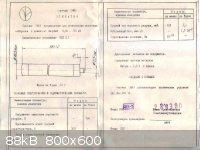
http://hardhack.org.au/neutron_monitor
From this link I find an idea for circuit design using these type tubes. You can see the tube is very lightly coupled, using a 10 picofarad capacitor.
The tube used is a Boron Coated Cathode Corona Pulse Neutron Tube SI-19N.

Obviously for my tube the voltage will be 1,300 volts not 2,200 volts. Still have to search for something which explains the operation of these corona
tubes in more detail. They give a starting voltage usually around 700 volts. Since when the counter is powered my tube will have a steady 1,300 volts,
I am not sure what they mean by a 700 volt starting voltage. I spent some time looking around, even some fusor sites as Marvin mentioned. However it
seems endless hours never finding a single source where a decent tutorial of corona tubes is discussed is always the result. If anyone has any decent
links that would be nice. For now I am going to keep searching before building circuitry in hopes of not having to build several prototypes.
Somewhere in these threads I remember someone asking how would a CCD be used in detection. Found this patent by accident looking for corona tubes. The
title seemed interesting enough to add the file in case anyone is interested.
Detector for thermal neutrons utilizing alternating boron slabs and CCD arrays - United States Patent 5399863
Attachment: US5399863.pdf (239kB)
This file has been downloaded 545 times
[Edited on 2-22-2014 by IrC]
"Science is the belief in the ignorance of the experts" Richard Feynman
|
|
|
bfesser
Resident Wikipedian
    
Posts: 2114
Registered: 29-1-2008
Member Is Offline
Mood: No Mood
|
|
I can't quite make out many of the characters on the latest datasheet (8X-CHM9.jpg). Any chance you could email a full-resolution scan to me?
Attachment: SNM9-SNM14.pdf (1.7MB)
This file has been downloaded 873 times
[Edited on 22.2.14 by bfesser]
|
|
|
Marvin
National Hazard
   
Posts: 995
Registered: 13-10-2002
Member Is Offline
Mood: No Mood
|
|
From Doug Coulter's forum,
Pulses out of SNM 18-1 (at last)
First light on CHM-14 Russian B10 neutron tube
Neutron detector tubes
There is also some information on the fusor forums but I became sidetracked reading through trying to find the posts.
|
|
|
| Pages:
1
..
3
4
5
6 |